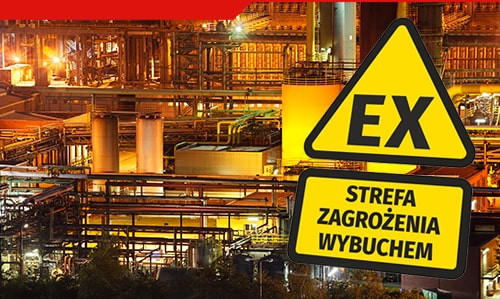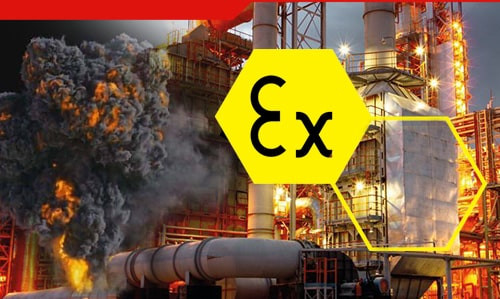

Category





Фотографии предназначены только для информационных целей. Посмотреть спецификацию продукта
please use latin characters
These are areas where flammable liquids, dusts, gases or vapors, with appropriate parameters flammable substances form mixtures with air which, under the influence of the source, are present ignition (most often sparks) can lead to an explosion. Explosion-proof themes it is an element of a wider issue, which is process safety.
In places defined as potentially explosive (EX) zones, it is necessary to maintain work safety both in terms of process and operation of devices electrical and mechanical. Explosive zones are defined by the Labor Code and Regulation of the Minister of Economy of 8 July 2010 on minimum requirements concerning occupational health and safety related to the possibility of occurrence in the place operation of an explosive atmosphere (Journal of Laws No. 138 item 931).
In the event of the presence of flammable and / or explosive substances in the plant, the employer is obliged to carry out a comprehensive Risk Assessment and Explosion Hazard Assessment, on the basis of which the Explosion Protection Document (DZPW) is prepared in accordance with the current regulations. The next step is to take actions consisting in the implementation of individually selected elements of explosion protection. One of the methods of reducing the risk is to train personnel working in areas with an explosive atmosphere in terms of process safety.
The DACPOL company offers Ex training / ATEX training. We organize both open trainings at the company's premises, as well as closed training: at the client's premises, tailored to the specificity of a given production plant or specific issues. The main topics of Ex training are issues in the field of broadly understood explosion safety in production plants with potentially explosive atmospheres. The training covers the most important issues resulting from the EU ATEX and ATEX User zone directives.
The training is intended for employees of enterprises and industrial plants in which there is an explosion hazard, flammable substances, where potentially explosive areas have been identified or are simply interested in the subject of process safety with an emphasis on explosion protection.
The most common training participants are:
Training courses are also a good introduction to the subject of explosion protection and can be the first step in the ATEX subject.
The participants of the advanced training receive a confirmation certificate at the end training that fulfills the obligations contained in:
The training should be repeated for a period not longer than that indicated in the approved EPD or shorter in the case of: a significant change in the work technology a significant change in the scope of explosion protection at the workplace.
DACPOL Sp. z o.o.
phone: (+48) 22 70 35 213
mobile: (+48) 722 266 997
address: Okulickiego 5J, 05-500 Piaseczno, Poland
e-mail: [email protected]
Вы заинтересованы в этом продукте? Вам нужна дополнительная информация или индивидуальные расценки?
Вы должны быть зарегистрированы
These are areas where flammable liquids, dusts, gases or vapors, with appropriate parameters flammable substances form mixtures with air which, under the influence of the source, are present ignition (most often sparks) can lead to an explosion. Explosion-proof themes it is an element of a wider issue, which is process safety.
In places defined as potentially explosive (EX) zones, it is necessary to maintain work safety both in terms of process and operation of devices electrical and mechanical. Explosive zones are defined by the Labor Code and Regulation of the Minister of Economy of 8 July 2010 on minimum requirements concerning occupational health and safety related to the possibility of occurrence in the place operation of an explosive atmosphere (Journal of Laws No. 138 item 931).
In the event of the presence of flammable and / or explosive substances in the plant, the employer is obliged to carry out a comprehensive Risk Assessment and Explosion Hazard Assessment, on the basis of which the Explosion Protection Document (DZPW) is prepared in accordance with the current regulations. The next step is to take actions consisting in the implementation of individually selected elements of explosion protection. One of the methods of reducing the risk is to train personnel working in areas with an explosive atmosphere in terms of process safety.
The DACPOL company offers Ex training / ATEX training. We organize both open trainings at the company's premises, as well as closed training: at the client's premises, tailored to the specificity of a given production plant or specific issues. The main topics of Ex training are issues in the field of broadly understood explosion safety in production plants with potentially explosive atmospheres. The training covers the most important issues resulting from the EU ATEX and ATEX User zone directives.
The training is intended for employees of enterprises and industrial plants in which there is an explosion hazard, flammable substances, where potentially explosive areas have been identified or are simply interested in the subject of process safety with an emphasis on explosion protection.
The most common training participants are:
Training courses are also a good introduction to the subject of explosion protection and can be the first step in the ATEX subject.
The participants of the advanced training receive a confirmation certificate at the end training that fulfills the obligations contained in:
The training should be repeated for a period not longer than that indicated in the approved EPD or shorter in the case of: a significant change in the work technology a significant change in the scope of explosion protection at the workplace.
DACPOL Sp. z o.o.
phone: (+48) 22 70 35 213
mobile: (+48) 722 266 997
address: Okulickiego 5J, 05-500 Piaseczno, Poland
e-mail: [email protected]
 Ochrona przeciwwybuchowa - Podział na strefy zagrożone wybuchem
Ochrona przeciwwybuchowa - Podział na strefy zagrożone wybuchem
 Warunki techniczne dla stref zagrożonych wybuchem
Warunki techniczne dla stref zagrożonych wybuchem
Не удаётся отправить вашу оценку отзыва
Пожаловаться на комментарий
Жалоба отправлена
Не удаётся отправить вашу жалобу
Оставьте свой отзыв
Отзыв отправлен
Не удаётся отправить отзыв
